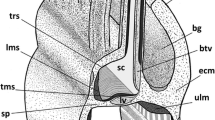Summary
The ultrastructure of the flame bulbs, protonephridial capillaries and duct of fully developed and regenerating Stenostomum sp. is described. Flame bulbs are formed by a single cell whose nucleus is located basally or laterally to the weir. The weir is formed by a single row of transverse ribs connected by a thin ‘membrane’, apparently of extracellular matrix. Internal leptotriches arise from the proximal cytoplasm and extend in a (usually) single row along the weir and into the lumen of the distal cytoplasmic tube. Many or all leptotriches do not fuse with the distal cytoplasm. Two cilia are each anchored in the proximal cytoplasm by a cross-striated vertical and lateral rootlet, the latter bent forward and extending for some distance into one of the two cytoplasmic cords along the weir. Each cord contains the lateral rootlet in its proximal part, as well as many microtubules. The distal cytoplasmic tube contains two (longitudinal) junctions, i.e. lines of contact between cell processes of the same, terminal cell. Occasionally, more than two junctions were seen, apparently due to branches of the terminal cell in contact with each other. Flame bulbs join capillaries lined by several canal cells type I, containing few or no microvilli but lateral flames. Such capillaries join a duct (or ducts?) lined by canal cells type II with many long microvilli. The large protonephridial duct is lined by numerous cells with lateral flames and many long microvilli. In regenerating tissue (10.5 hours after cutting) some flame bulbs were ‘free’, i.e. not connected to capillaries, and some capillaries openly communicated with the surrounding intercellular space. In the presence of a single row of ribs in the weir, of internal leptotriches, and of vertical and lateral ciliary rootlets, the flame bulb of Stenostomum sp. resembles that of other Plathelminthes much more closely than hitherto thought. The species differs from non-catenulid plathelminths mainly in the large number of glandular cells lining the large protonephridial ducts, in the transverse orientation of the ribs in the weir and in the presence of only two cilia in the flame.
Similar content being viewed by others
References
Borkott H (1970) Geschlechtliche Organisation, Fortpflanzungsverhalten und Ursachen der sexuellen Vermehrung von Stenostomum sthenum nov. spec. (Turbellaria, Catenulida). Z Morphol Tiere 67:183–262
Brandenburg J (1966) Die Reusenformen der Cyrtocyten. Eine Beschreibung von fünf weiteren Reusengeißelzellen und eine vergleichende Betrachtung. Zool Beitr 12:345–417
Ehlers U (1985) Das phylogenetische System der Plathelminthes. Gustav Fischer, Stuttgart, New York
Hyman LH (1951) The Invertebrates: Platyhelminthes and Rhynchocoela. McGraw-Hill, New York
Kümmel G (1962) Zwei neue Formen von Cyrtocyten. Vergleich der bisher bekannten Cyrtocyten und Erörterung des Begriffes, “Zelltyp”. Z Zellforsch 57:172–201
Kümmel G (1965) Druckfiltration als ein Mechanismus der Stoffausscheidung bei Wirbellosen. In: Funktionelle und morphologische Organisation der Zelle. Sekretion und Exkretion. Springer, Berlin, pp 203–227
Kümmel G (1977) Der gegenwärtige Stand der Forschung zur Funktionsmorphologie exkretorischer Systeme. Versuch einer vergleichenden Darstellung. Verh Dtsch Zool Ges 1977:154–174
Moraczewski J (1981) Fine structure of some Catenulida (Turbellaria, Archoophora). Zool Poloniae 28:367–415
Ott HN (1892) A study of Stenostoma leucops O. Schm. J Morphol 7:263–304
Reisinger E (1976) Zur Evolution des stomatogastrichen Nervensystems bei den Plathelminthen. Z Zool Syst Evol 14:241–253
Rohde K (1991) The evolution of protonephridia of the Platyhelminthes. Hydrobiologia 227:315–321
Rohde K, Watson N, Cannon LRG (1987) Ultrastructure of the protonephridia of Mesostoma sp. (Rhabdocoela, ‘Typhloplanoida’). J Submicrosc Cytol 19:107–112
Sterrer W, Rieger R (1974) Retronectidae — new cosmopolitan marine family of Catenulida (Turbellaria) In: Riser NW, Morse MP (ed) Biology of the Turbellaria, McGraw-Hill, New York, pp 63–92
Author information
Authors and Affiliations
Rights and permissions
About this article
Cite this article
Rohde, K., Watson, N.A. Ultrastructure of the protonephridial system of regenerating Stenostomum sp. (Plathelminthes, Catenulida). Zoomorphology 113, 61–67 (1993). https://doi.org/10.1007/BF00430977
Received:
Issue Date:
DOI: https://doi.org/10.1007/BF00430977




